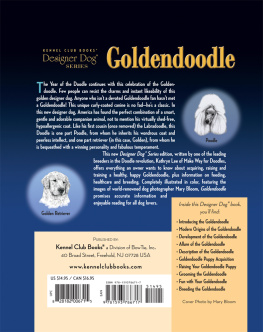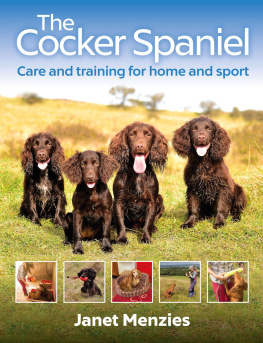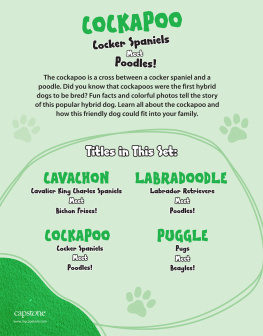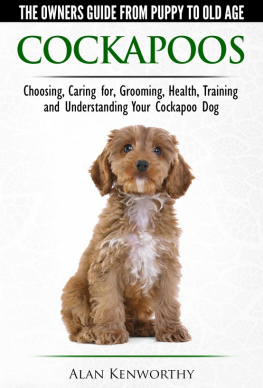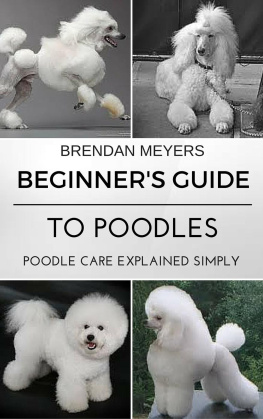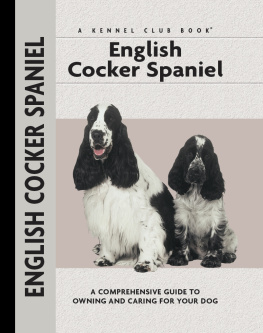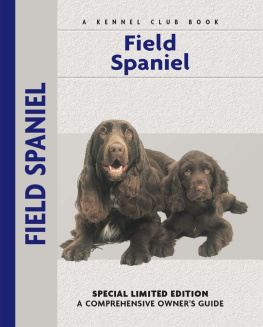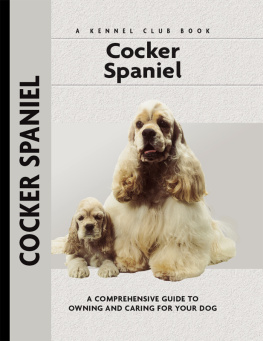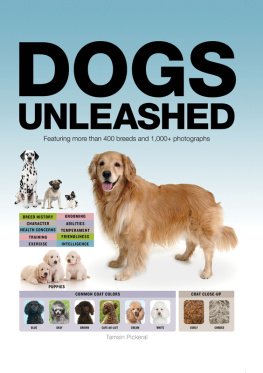Lt. Col. Mary D. Foley USA (Ret.) has been involved with Cockapoos since the early 1980s when she began her All American Cockapoos kennel. With the assistance of fellow Cockapoo lovers, she founded the Cockapoo Club of America, the first organization ever to be dedicated to a designer dog. She holds the title of president emeritus of the club. Currently residing in Florida with Cockapoos, Peaches and Panda, she is shown here with Patches, second generation, and Hercules, ninth generation.
Meet Mia, a four-year-old Cockapoo, who lives with her adoring owners and caregivers Bob and Mary Buten in Aberdeen, New Jersey. Mia is a sable and white Cockapoo who was bred by Carol Bobrowsky of Mulberry Farm Cockapoos. Mias favorite activities include playing ball and Frisbee. She loves all people, especially children, and she sleeps in her parents bed, of course. In her spare time, she eats cheese.
KENNEL CLUB BOOKS
Designer Dog
SERIES
C OCKAPOO
ISBN: 1-59378-591-7
eISBN: 978-159378713-4
Copyright 2006 Kennel Club Books An Imprint of I-5 Press A Division of I-5 Publishing, LLC
3 Burroughs, Irvine, CA 92618 USA
Printed in South Korea
Photography by:
Don Ayres, Paulette Braun, Bernd Brinkmann, Debbie Cowdrey, Isabelle Francais, Bill Jonas, Jean M. Maruejouls, Jackie Rusk and Karen Taylor.
The publisher would like to thank all of the owners and breeders whose dogs are featured in this book, including Don Ayres, Ken and Patti Bolduc, the Butens, Debbie Cowdrey, Donna Fario, Mary Foley, Monique and Paul Freed, the Gilchrists, the Kimballs, the Kowalskis, Jean M. Maruejouls, Jill McGillam, Kris OShaugnessy Brian and Carol Potter, Patti and Ken Ross, Jackie Rusk, the Satarianos and the Stokes.
All rights reserved. No part of this book may be reproduced in any form, by photostat, scanner, microfilm, xerography or any other means, or incorporated into any information retrieval system, electronic or mechanical, without the written permission of the copyright owner.
10 9 8 7 6 5 4 3 2 1

The Cockapoo is a hybrid: the perfect combination of style, intelligence and affection.
Acknowledgments
The author wishes to thank the following people for their invaluable help during the production of this book: Dr. Marjorie Rust, for introducing me to her Cockapoo, Frederick, over 30 years ago and for keeping my old laptop going so I could write the book; Fred Oehme, DVM, Ph.D., Veterinary Toxicologist, Kansas State University, for invaluable assistance with the section on poisonous substances in dogs; Josie Montenari, President, Cockapoo Club of America, who steered the publisher to me and got the ball rolling; Debbie Cowdrey of Starlos kennels, for patiently answering all my questions and providing many wonderful pictures; Jackie Rusk of Camano Island Cockapoos, for her pictures and continued support throughout the project; Jeannie Maruejouls, for taking scads of pictures and helping to sort them; and most of all, all the wonderful people who adopted and loved my Cockapoos when I was breeding, kept in touch over the years and provided me with feedback and encouragement.

Contents

The Cocker Spaniel is the dapper daddy of this designer dog.

The font of all Poos: the Miniature Poodle is the starting point for the Cockapoo.
History of the Cockapoo
I t is a well-known fact that the Poodle is among the most intelligent of dogs, probably second only to the Border Collie. Poodles date back to the Middle Ages and were used by hunters as waterfowl retrievers because of their high trainability, superb swimming ability and buoyant coats and as truffle hunters because of their miraculous noses. Today Poodles are prized for their intelligence, elegance, alertness, sociability and grace. They are easy to train to do tricks and seem almost human at times. One thing not mentioned in Poodle literature is that they can be extremely good guard dogs. Thick woolly coats demand frequent brushing in between trips to the grooming salon. But they are low-shedding and hypoallergenic, and they do not have doggy odor. (Non-shedding is a misnomer, but the term low-shedding is more accurate, i.e., hair comes out on the brush but is not found in any significant quantity around the house.) Some people groom their own Poodles and spin the wool into yarn. In the US, the Poodle is divided into three sizes, Standard, Miniature and Toy; the Miniatures are most frequently used in Cockapoo crosses.
The Cocker Spaniel was also bred long ago in Europe to hunt the woodcock, a woodland bird of the sandpiper family. Like Poodles, Cockers have excellent noses for scenting and they, too, are great swimmers and retrievers. Cocker Spaniels, by definition, are merry little dogs, devoted to their families and with an inherent love of children. They are known to be very intelligent and quick learners. Their coats are extremely thick, particularly on the legs, ears and chest, and grooming, as in the Poodle, is very demanding. Unlike the Poodle, the Cocker sheds profusely and tends to have some doggy odor. Throughout the world, there are two breeds of Cocker, the American Cocker, the more popular in the US, more profusely coated breed, and the English Cocker, less common in the US but very popular in the UK.

Make way, America, for designer dogsheres the Cockapoo!
Both the Poodle and Cocker have been high in popularity for many years and have been bred by American breeders to develop beautiful show dogs, sometimes to the detriment of health and temperament. Some poorly bred Poodles are infamous for their high-strung behavior and constant barking. Some American Cockers have also become nervous and high-strung and prone to rage syndrome and skin disorders. Each breed, because of inferior breeding practices and mass production by profit-minded kennels, is prone to many genetic diseases. Heritable eye disease in both breeds is one of the most prominent, leading to early cataracts, glaucoma and blindness.


